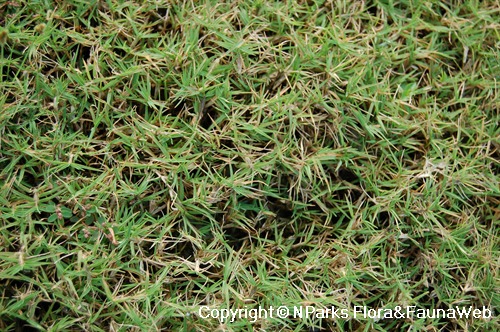
Back
Cynodon dactylon (L.) Pers.
| Family Name: | Poaceae (Gramineae) |
| Synonyms: | Panicum dactylon L., Cynodon glabratus |
| Common Name: | Bermuda Grass, Bahama Grass, Kweek, Doob, Couch, Star Grass, Bermuda Tiff Dwarf, Rumput Minyak, 狗牙根, 百慕达草 |
Name
Classifications and Characteristics
| Plant Division | Angiosperms (Flowering Seed Plants) (Monocotyledon) |
|---|---|
| Plant Growth Form | Grass or Grass-like Plant (Short Grass (Poaceae)) |
| Lifespan (in Singapore) | Perennial |
| Mode of Nutrition | Autotrophic |
| Plant Shape | Grassy |
Biogeography
| Native Distribution | Pantropical |
|---|---|
| Native Habitat | Terrestrial (Disturbed Area / Open Ground), Shoreline (Sandy Beach) |
| Preferred Climate Zone | Tropical, Sub-Tropical / Monsoonal |
| Local Conservation Status | Non-native (Spontaneous (Naturalised)) |
Description and Ethnobotany
| Growth Form | It is a herb that consists of creeping, well-developed wiry stolons (horizontal stem growing at ground level) from which arise, roots and up to 40 cm tall flowering stems. |
|---|---|
| Foliage | Its erect, flowering stem bears leaves in two rows. Its leaves consist of a sheath, and leaf blades that are blue-green, linear-acute, and 5–120 by 1–4 mm. |
| Flowers | Its flowering shoot consist of 3–6 horizontally spreading branches that are each up to 7 cm long, with compact flower clusters (spikelets) borne along the length. Its stalkless, alternate spikelets are laterally flattened, often purplish, 2.4–2.5 by 1.3–1.9 mm, and contain one tiny flower (floret) each. |
| Fruit | Its fruit is 1 mm long. |
| Habitat | It grows in lawns, open grasslands, on seashores, and sandy soil. |
| Associated Fauna | It is the preferred local food plant for caterpillars of the butterfly, the common five ring (Ypthima baldus newboldi). It is also the preferred local food plant for caterpillars of the moths, Agrotis biconica, the black cutworm (Agrotis ipsilon), Lamprosema asaphialis, Salebria inhonesta, the dark mottled willow or grass lawn armyworm (Spodoptera cilium), and the African armyworm (Spodoptera exempta). |
| Cultivation | It can be propagated by splitting the clumps or by seeds. |
| Etymology | Greek kyon, a dog; Greek odous, a tooth, referring to the tooth-shaped buds of the stolons; Latin dactylon, finger, referring to the finger-like arrangement of its flowering shoots |
| Ethnobotanical Uses | Medicinal: Cynodin, hydrocyanic acid, and triticin are said to be found in the plant. It is also employed in medicine against various ailments and diseases. Others: The plant is used as forage grass for feeding livestock, especially in wetter areas where it is more abundant. |
Landscaping Features
| Landscaping | Bermuda is widely adapted to soils and climate. It is often selected for use on sport lawn and golf courses due to its drought & flood tolerance, heat tolerance and traffic tolerance. |
|---|---|
| Desirable Plant Features | Ornamental Foliage |
| Landscape Uses | Suitable for Roadsides, Parks & Gardens, Small Gardens, Coastal, Beachfront / Shoreline, Suitable for Rooftops, Groundcover, Turf / Lawn / Sports Field |
Fauna, Pollination and Dispersal
| Fauna Pollination Dispersal Associated Fauna | Butterfly Host Plant, Caterpillar Moth Food Plant |
|---|---|
| Pollination Method(s) | Abiotic |
| Seed or Spore Dispersal | Abiotic |
Plant Care and Propagation
| Light Preference | Full Sun, [Remarks] (It will dies out under medium to dense shade.) |
|---|---|
| Water Preference | Moderate Water |
| Rootzone Tolerance | Drought Tolerant, Moist Soils, Well-Drained Soils, Saline Soils / Salt Spray, Poor Infertile Soils, Fertile Loamy Soils, Easy to Grow |
| Planting Remarks | Vegetative Methods: Close turfing: irregular, small sod pieces placed together Open turfing: 50-70mm diameter rooted pieces planed on 300mm centers. Close and open turfing result in irregular turf surface, requiring at least 2 post-plant topdressing and rollings. Sodding:uniformly thick, cut turf sheets or rolls placed together. Roll after planting. Results in high quality, level turf surface. Seeding: 5-8kg live seed/1000 square meters. Post seeding mulch required. |
| Transplanting Tolerance | Good |
| Pruning | Streetscape: Require mowing every 14-21 days to maintain the height of 45-60mm. Parks: Require mowing every 7-12 days to maintain the height of 25-40. Event and sports lawns: Require mowing every 6-8 days to maintain the height of 20-30cm. |
| Fertilizing | Use turf-grass type fertilizer with basic N-P-K ratio of 4-1-2 or 4-1-1.Properly calibrate spreader or sprayer to apply above rates on the basis of N(nitrogen). (Ex. urea is 45% N, therefore 1kg N = 2,2kg urea) Streetscape: 0.1 - 0.2 kg of N per 100 square meters per month. Parks: 0.3 - 0.4 kg of N per 100 square meters per month. Event and sports lawns: 0.5 - 0.7kg of N per 100 square meters per month. |
| Propagation Method | Seed, Stolon / Runner |
Foliar
| Foliage Retention | Evergreen |
|---|---|
| Mature Foliage Colour(s) | Green |
| Mature Foliage Texture(s) | Smooth |
| Foliar Type | Simple / Unifoliate |
| Foliar Shape(s) | Non-Palm Foliage (Linear) |
| Foliar Venation | Parallel |
| Foliar Margin | Entire |
| Leaf Area Index (LAI) for Green Plot Ratio | 2.0 (Turfgrass) |
Floral (Angiosperm)
| Flower & Plant Sexuality | Bisexual Flowers |
| Flower Colour(s) | Purple |
|---|---|
| Flower Grouping | Cluster / Inflorescence |
Fruit, Seed and Spore
| Fruit Classification | Simple Fruit |
|---|---|
| Fruit Type | Indehiscent Dry Fruit , Caryopsis / Grain |
Image Repository
Others
| Master ID | 624 |
|---|---|
| Species ID | 1919 |
| Flora Disclaimer | The information in this website has been compiled from reliable sources, such as reference works on medicinal plants. It is not a substitute for medical advice or treatment and NParks does not purport to provide any medical advice. Readers should always consult his/her physician before using or consuming a plant for medicinal purposes. |
